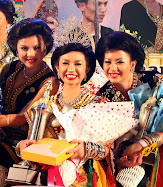

When she first appeared on the cover of National Geographics' June 1985 issue, she immediately captured the world's imaginations.
Yet nobody knows her name, not even Steve Mc Curry who photoghaphed this iconic photo in 1984 at an Afghanistan refugee camp in Pakistan.
Steve Mc Curry happened to meet this girl by chance.
Her big sharp and haunting green eyes definitely captivated the eyes the world, symbolising the tragedy, pain and hardship endured by Afghanistan women in times of war and the subsequent refugees crisis.
"I didn't think the photograph of the girl would be different from anything else I shot that day," he recalls of that morning in 1984 spent documenting the ordeal of Afghanistan's refugees.
The photograph was known as "The Afghan Girl" and nobody knows her name until 17 years later in 2002.
In January 2002, a team from National Geographic Television & Film's EXPLORER brought McCurry to Pakistan to search for the Afghan Girl.
They showed her picture around Nasir Bagh, the still standing refugee camp near Peshawar where the photograph had been made.
A teacher from the school claimed to know her name. A young woman named Alam Bibi was located in a village nearby, but McCurry decided it wasn't her.
No, said a man who got wind of the search. He knew the girl in the picture.
They had lived at the camp together as children. She had returned to Afghanistan years ago, he said, and now lived in the mountains near Tora Bora. He would go get her.
It took three days for her to arrive. Her village is a six-hour drive and three-hour hike across a border that swallows lives.
When McCurry saw her walk into the room, he thought to himself: This is her.



Her name is Sharbat Gula, and she is Pashtun.
The Pashtun is the most warlike of Afghan tribes.
It is said of the Pashtun that they are only at peace when they are at war, and her eyes—then and now—burn with ferocity.
She is 28, perhaps 29, or even 30. No one, not even she, knows for sure. Stories shift like sand in a place where no records exist.
Time and hardship have erased her youth.
Her skin looks like leather.
The geometry of her jaw has softened. The eyes still glare; that has not softened.
"She's had a hard life," said McCurry. "So many here share her story."
Consider the numbers. Twenty-three years of war, 1.5 million killed, 3.5 million refugees: This is the story of Afghanistan in the past quarter century.
"The Russian invasion destroyed our lives," her brother said.
It is the ongoing tragedy of Afghanistan. Invasion. Resistance. Invasion. Will it ever end?
We know after the Russian left, Afghanistan was invaded by the United States of America hunting for Al Qaeda and Osama bin Laden after the Sept 11, 2001 attacks on the United States which felled 2 twin towers in New York and ravaged the Pentagon.
"Each change of government brings hope," said Yusufzai, an Afghanistan journalist.
"Each time, the Afghan people have found themselves betrayed by their leaders and by outsiders professing to be their friends and saviors."
In the mid-1990s, during a lull in the fighting, Sharbat Gula went home to her village in the foothills of mountains veiled by snow.
To live in this earthen-colored village at the end of a thread of path means to scratch out an existence, nothing more.
There are terraces planted with corn, wheat, and rice, some walnut trees, a stream that spills down the mountain, except in times of drought, but no school, clinic, roads, or running water.
Here is the bare outline of her day.
Sharbat Gula rises before sunrise and prays.
She fetches water from the stream. She cooks, cleans, does laundry.
She cares for her children; they are the center of her life. in 2002, Robina is 13. Zahida is three. Alia, the baby, is one.
A fourth daughter died in infancy. Sharbat has never known a happy day, her brother says, except perhaps the day of her marriage.
Her husband, Rahmat Gul, is slight in build, with a smile like the gleam of a lantern at dusk.
Sharbat Gula remembers being married at 13. No, he says, she was 16. The match was arranged.
He lives in Peshawar because there are few jobs in Afghanistan and works in a bakery.
He bears the burden of medical bills; the dollar a day he earns vanishes like smoke.
Her asthma, which cannot tolerate the heat and pollution of Peshawar in summer, limits her time in the city and with her husband to the winter. The rest of the year she lives in the mountains.
At the age of 13, Yusufzai, the journalist, explained, she would have gone into purdah, the secluded existence followed by many Islamic women once they reach puberty.
"Women vanish from the public eye," he said. In the street she wears a plum-colored burka, which walls her off from the world and from the eyes of any man other than her husband. "It is a beautiful thing to wear, not a curse," she says.
Faced by questions, she retreats into the black shawl wrapped around her face, as if by doing so she might will herself to evaporate. The eyes flash anger. It is not her custom to subject herself to the questions of strangers.
Had she ever felt safe?
"No. But life under the Taliban was better. At least there was peace and order."
Had she ever seen the photograph of herself as a girl?
"No."
She can write her name, but cannot read. She harbors the hope of education for her children. "I want my daughters to have skills," she said. "I wanted to finish school but could not. I was sorry when I had to leave."
Education, it is said, is the light in the eye. There is no such light for her. It is possibly too late for her 13-year-old daughter as well, Sharbat Gula said. The two younger daughters still have a chance.
The reunion between the woman with green eyes and the photographer was quiet.
On the subject of married women, cultural tradition is strict. She must not look—and certainly must not smile—at a man who is not her husband.
She did not smile at McCurry. Her expression, he said, was flat. She cannot understand how her picture has touched so many. She does not know the power of those eyes.
Such knife-thin odds. That she would be alive. That she could be found. That she could endure such loss. Surely, in the face of such bitterness the spirit could atrophy. How, she was asked, had she survived?
The answer came wrapped in unshakable certitude.
"It was," said Sharbat Gula, "the will of God."
One thing for sure here, Steve Mc Curry and Sharbat Gula still remember the chance encounter which resulted in the amazing Afghan Girl potrait.

































No comments:
Post a Comment